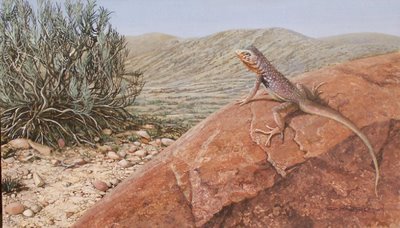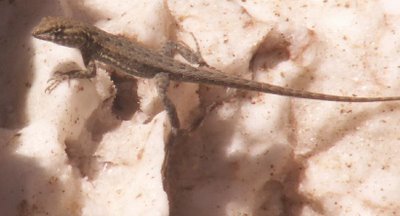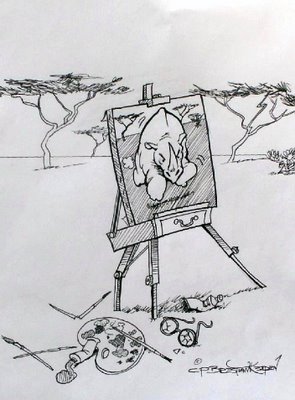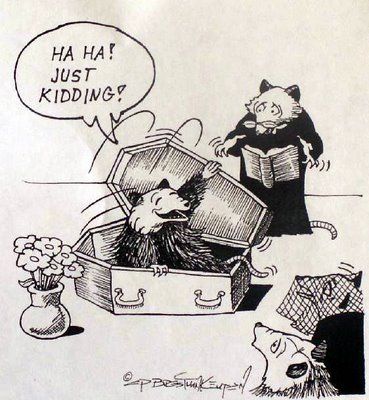
Many centuries ago, a shepherd came upon an injured European Nightjar (
Caprimulgus europaeus) that hissed and gaped in a threat display. Referring to what he knew best, he noticed the bird's wide gape and capacious gullet seemed to correspond to the size and shape of a goat's teat. My tale is purely speculative, but it's as good a guess as any for the origin of the old and widespread myth that these birds milk goats. In many tongues, the word for “nightjar” translates to “goatsucker,” as does the Latin
Caprimulgus, bestowed by Linnaeus in 1758. Aristotle recounted the behavior as fact 24 centuries ago in his
Liber Animalium. Of course, the birds' huge maws actually function as catcher's mitts when they feed on the wing. A complex mechanism of jaw and skull opens the mouth horizontally as well as vertically, and is peculiar to the group. Except in the nighthawks (
Chordeiles spp.), the catching area is increased by long rictal bristles rimming the mouth. Another anomaly is the presence of a tapetum, or reflecting layer of the retina, which gives the birds a fiery red eye-shine when viewed with a torch at night. Despite being well distributed through most of the world, their nocturnal habits shroud them in mystery. The IUCN lists 22 of the 120 species of Caprimulgiformes as endangered, including the Nechisar Nightjar (
Caprimulgus solala), known only from an Ethiopian roadkill found in 1990. The order Caprimulgiformes has traditionally included the nightjars (family Caprimulgidae), as well as the South American pottoos (family Nyctibiidae) and Oilbird (family Steatornithidae), and the Australasian frogmouths (family Podargidae) and owlet-nightjars (family Aegothelidae), and has been placed between the owls (Strigiformes) and swifts (Apodiformes). Sibley and Ahlquist agreed with the owl connection to the extent of placing the group within the the Strigiformes, in two suborders, one for the owlet-nightjars and one for the rest. In their recent cladistic revision, Fain and Houde put goatsuckers in the clade Metaves, with the swifts and pigeons. It's extremely hard for me to deny a close kinship to owls, particularly the barn and bay owls or tytonids, based merely on structural and behavioral similarities. In this post, I'll use the traditional taxonomy, which still makes good sense to me.
Two nightjar species were plentiful where I grew up: Common Poorwills (
Phalaenoptilus nuttallii) and Common Nighthawks (
Chordeiles minor). I found the nesting area of a pair of the latter species when I was eight, and mistook them for some type of falcon. Each morning I hiked to the top of the hill behind our house, where they would flush and perch a few yards away. I set box traps baited with carrion in a naïve effort to catch one, never realizing that there was surely a nest just a few feet away.

As with other nightjars, nighthawks normally lay a pair of eggs directly on the ground, and they are usually quite hard to find. The hen sits very tight, normally flushing only to avoid being stepped on. In cities they often nest on flat rooftops, and will sometimes use a tree stump or even an abandoned Robin nest. The photo above shows the nest of a Pauraque (
Nyctidromus albicollis), a common Neotropical species, in a rainforest habitat. The egg was fresh, and was probably followed by a second one the next day. Although nesting behavior for nightjars is fairly uniform, it differs greatly among the other caprimulgiform families. The owlet-nightjars lay 2-5 eggs in a feather and leaf-lined tree cavity, while the frogmouths build a stick nest for their one to two eggs. Pottoos balance their single egg in a depression on a tree branch or snag. The most unusual member of this unusual group, the frugivorous Oilbird (
Steratornis caripensis), nests in colonies inside caves, building platforms of mud, feces, and rotten fruit to cradle their 1-4 eggs. Bird chicks are often categorized as either altricial (born helpless and naked) or precocial (able to run about shortly after hatching). Young nightjars fall somewhere in between, though the other caprimulgiformes begin life as classically altricial youngsters. The incubation period for Common Nighthawks is 17-20 days, and for the first week and a half or so, the chicks are brooded almost constantly by the parents. They can move about on their tiny legs fairly well from the start, and the “nest” tends to meander from day to day, often to avoid hot sunshine. Both adults feed the chicks regurgitated insects.

If a nest is disturbed, one or both parent birds will often threaten an intruder by spreading their wings, gaping, hissing, and bill-clapping, like the Madagascar Nightjar (
Caprimulgus madagascariensis) in the center photo. If pressed, they will sometimes affect a broken-wing display, as the same bird demonstrates in the lower shot. I've found Poorwills to be particularly demonstrative about the nest; the roosters will often fly about one's head, wing-clapping like a
Long-eared Owl. The chicks also threaten boldly, hissing, bill-clapping, and wing-waving, before running for cover.
As my knowledge progressed past the point of being able to distinguish nighthawks from falcons, I learned an easy method for the capture of nightjars. I kept a male Poorwill for several weeks as a teenager, and was immediately struck by his Barn Owl-like form and behavior. The threat displays of the two are nearly identical: hissing and bill-clapping, paired with an odd swaying to-and-fro. Among the shared physical traits was a toothed, or pectinated, middle toenail, a characteristic also common to herons. Where a Barn Owl's toenail teeth are reduced to little more than lines, a Poorwill's are very well developed, and my little bird used them frequently to groom and disentangle the long rictal bristles around his mouth. These odd birds are probably best known for a most unbird-like behavior. Reports of hibernating Poorwills go back a couple of centuries, but it wasn't until 1946 that Edmund Jaeger confirmed them by observing an individual in the mountains of southern California. A number of birds can lower their metabolic rates to a point of semi-torpor; hummingbirds would starve without the ability to do it nightly, but no other bird can match the Poorwill's skills in this field. They can survive a body cooling to 5°C, and can still fly when their temperature drops as low as 27.4°C. Interestingly, they appear to eat far more beetles than do other nightjars. Beetles are very high in unsaturated fats, which remain liquid, and metabolically available, at low temperatures.

While Poorwills sleep through the cold, most other nightjars migrate from temperate climes, often in large, loose flocks. I know a small lake where one can dependably watch hundreds of Common Nighthawks on an early September evening, feeding up before continuing on to South America. The birds' spring return is even more magnificent, since it often includes the
nuptial display of the males, where a vertical stoop of one hundred feet is suddenly broken with a spread of wings, and a loud howl of vibrating primaries. The males of some nightjar species embellish their displays with outrageous feather ornamentation, most notably the long scissor tails of the South American genera
Macropsalis,
Uropsalis and
Hydropsalis, and the otherworldly second-innermost primaries of the two African
Macroditeryx species. In the Pennant-winged Nightjar (
M. vexillarius), these feathers are gleaming white and two feet long. In the Standard-winged Nightjar (
M. longipennis), they are barbless for most of their length, poking up from the wing before ending in a large, oval flag.

Common Nighthawks are found in most of the United States and southern Canada, except in the Mojave Desert, where they are replaced by the similar Lesser Nighthawk (
Chordeiles acutipennis). This species is a bit smaller and less boldly marked, and is a bit daintier in every respect. The male's nuptial flight lacks the ostentation of his larger cousin, and the normal flight is less powerful, and a bit more tern-like. Last week I returned from a trip to the Mojave, and on my way home, I stopped at one of my regular haunts: a lone streetlight in the middle of the desert, where Lesser Nighthawks exploit an abundance of moths. Where Common Nighthawks at a streetlight are seen for but a second, the slower, lower-flying Lessers can be watched quite clearly, hovering for a moment...adjusting their flight...changing their mind...it's addictive to watch. Shortly after dusk, a lone streetlamp in the Mojave is always worth stopping for.

Finally, a little note about the top drawing: I drew it for my personal Christmas card last year. If you give it some thought, you may actually realize a holiday theme. The nightjar species depicted are (left to right): the South American Sand-colored Nighthawk (
Chordeiles rupestris), the African Long-tailed Nightjar (
Caprimulgus climacurus), the Southeast Asian Large-tailed Nightjar (
Caprimulgus macrurus), the North American Common Nighthawk (
Chordeiles minor), and the Neotropical Pauraque (
Nyctidromus albicollis).
_____________________
upper: CONSTERNATION OF PAN (2005) pen & ink 12" x 9"
second: Paraque egg photographed in SE Ecuador by CPBvK 1997
third: Madagascar Nightjar photographed near Isalo, Madagascar by CPBvK 1996
fourth: PENNANT-WINGED NIGHTJAR (1998) ink wash 23" x 17"
fifth: TWO STORIES--COMMON NIGHTHAWK (1994) acrylic 22" x 30"
lower: Lesser Nighthawk photographed in Washington Co., UT by CPBvK 8-04-06
 Okay, lots of carnivals this time around. First off, It's the Carnival of the Green, with the best environmentally-minded blogging of the past two weeks. This time our host is the Disillusioned Kid.
Okay, lots of carnivals this time around. First off, It's the Carnival of the Green, with the best environmentally-minded blogging of the past two weeks. This time our host is the Disillusioned Kid. If that's not leftie enough for you, try the Carnival of Liberals #20, where Ridger, of The Greenbelt has selected his favorite ten blog postings representing a liberal viewpoint. Take a walk with him.
If that's not leftie enough for you, try the Carnival of Liberals #20, where Ridger, of The Greenbelt has selected his favorite ten blog postings representing a liberal viewpoint. Take a walk with him. Meanwhile, over at Migrateblog, Mariya is hosting the 31st edition of I and the Bird, the birding carnival. If you're not going to read the posts, at least read the haikus she wrote for each one.
Meanwhile, over at Migrateblog, Mariya is hosting the 31st edition of I and the Bird, the birding carnival. If you're not going to read the posts, at least read the haikus she wrote for each one. And over at Epigenetics News, it's edition #61 of Tangled Bank, with the best science blogging of the past two weeks.
And over at Epigenetics News, it's edition #61 of Tangled Bank, with the best science blogging of the past two weeks. Circus of the Spineless, the carnival devoted to all things invertebrate, is hosted this month by Steve Reuland at Sunbeams from Cucumbers.
Circus of the Spineless, the carnival devoted to all things invertebrate, is hosted this month by Steve Reuland at Sunbeams from Cucumbers.










































